New Zealand kaka
The New Zealand kaka (Māori: kākā) (Nestor meridionalis) is a large species of parrot of the family Nestoridae found in native forests of New Zealand. Two subspecies are recognised. It is endangered and has disappeared from much of its former range.
| New Zealand kaka | |
|---|---|
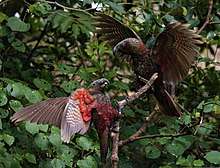 | |
| A pair of North Island kaka in Zealandia, Wellington, New Zealand | |
| Scientific classification | |
| Kingdom: | Animalia |
| Phylum: | Chordata |
| Class: | Aves |
| Order: | Psittaciformes |
| Family: | Nestoridae |
| Genus: | Nestor |
| Species: | N. meridionalis |
| Binomial name | |
| Nestor meridionalis (Gmelin, 1788) | |
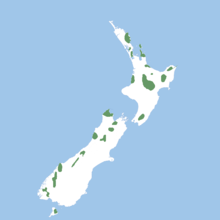 | |
| Range in green | |
Taxonomy and naming
The New Zealand kaka was described by German naturalist Johann Friedrich Gmelin in 1788. There are two subspecies, the North Island kaka, Nestor meridionalis septentrionalis, and the South Island kaka, N. m. meridionalis, although more recent research has ruled out allopatric subspeciation.[2] The Māori language name kākā means "parrot", possibly related to kā, 'to screech'.[3]
The genus Nestor contains four species: the New Zealand kaka (Nestor meridionalis), the kea (N. notabilis), the extinct Norfolk kaka (N. productus), and the extinct Chatham kaka (N. chathamensis). All four are thought to stem from a "proto-kaka", dwelling in the forests of New Zealand five million years ago.[4][5] Their closest relative is the kakapo (Strigops habroptilus).[4][5][6][7] Together, they form the parrot superfamily Strigopoidea, an ancient group that split off from all other Psittacidae before their radiation.[4][5][7][8]
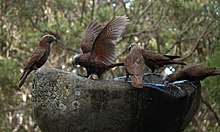
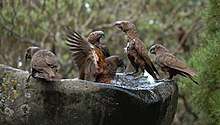
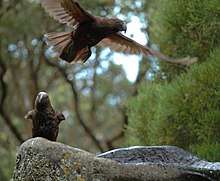
Description
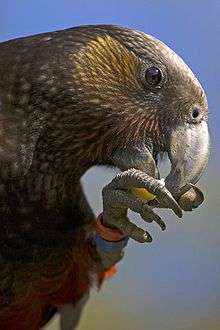
The New Zealand kaka is a medium-sized parrot, measuring 45 cm (18 in) in length and weighing from 390 to 560 g (14 to 20 oz), with an average of 452 g (0.996 lb).[9] It is closely related to the kea, but has darker plumage and is more arboreal. The forehead and crown are greyish white and the nape is greyish brown. The neck and abdomen are more reddish, while the wings are more brownish. Both sub-species have a strongly patterned brown/green/grey plumage with orange and scarlet flashes under the wings; colour variants which show red to yellow colouration especially on the breast are sometimes found.
This group of parrots is unusual, retaining more primitive features lost in most other parrots, because it split off from the rest around 100 million years ago.[10]
The calls include a harsh ka-aa and a whistling u-wiia.[11]
Distribution and habitat
The New Zealand kaka lives in lowland and mid-altitude native forest. Its strongholds are currently the offshore reserves of Kapiti Island, Codfish Island and Little Barrier Island. It is breeding rapidly in the mainland island sanctuary at Zealandia with over 800 birds banded since their reintroduction in 2002.[12] From their reintroduction in 2002 the North Island kaka continue to re-colonise Wellington and a recent report shows a significant increase in their numbers over the last 12 years.[13]
Behaviour
Kaka are mainly arboreal and occupy mid-to-high canopy. Often seen flying across valleys or calling from the top of emergent trees. They are very gregarious and move in large flocks often containing kea where present.
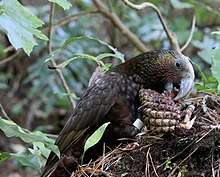
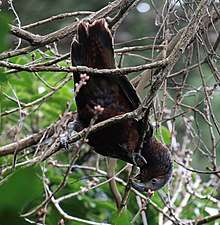
Diet
_in_flight.jpg)
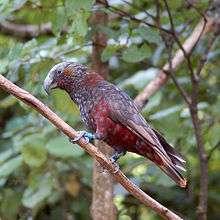
The New Zealand kaka eats fruits, berries, seeds, flowers, buds, nectar, sap, plants and invertebrates. It uses its strong beak to shred the cones of the kauri tree to obtain the seeds.[14] It has a brush tongue with which it feeds on nectar, and it uses its strong beak to dig out the grubs of the huhu beetle and to remove bark to feed on sap.[15]
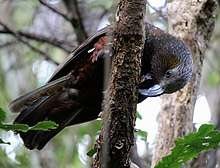
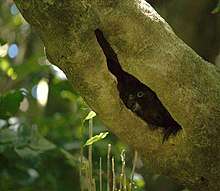
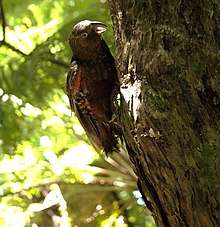
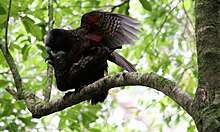
Nesting
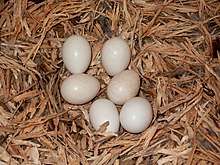
New Zealand kaka make their nests in hollow trees, laying clutches of 2 to 4 eggs in late winter. Both parents assist in feeding the chicks. In a good fruiting year pairs can double clutch often utilising the same nest hole for the second clutch. It is unusual for a pair to raise more than three chicks in a clutch.
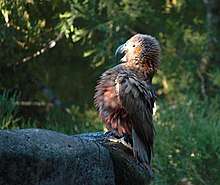
Conservation status
The New Zealand kaka is considered endangered (CITES II). It has greatly declined across its traditional range as a result of habitat loss, predation by introduced predators such as cats, rats, possums and stoats, and competition from wasps and bees for the honeydew excreted by scale insects. A closely related species, Nestor productus, the Norfolk kaka, became extinct in 1851 for similar reasons.
Predation
Predatory mammals are responsible for the loss of an estimated 26 million native birds and their eggs each year in New Zealand.[16]
As cavity nesters with a long incubation period that requires the mother to stay on the nest for at least 90 days, kaka are particularly vulnerable to predation. Stoats were the main cause of death of nesting adult females, nestlings and fledglings, but possums were also important predators of adult females, eggs and nestlings.[17] There is strong evidence that predation of chicks and females has led to a serious age and sex imbalance, even amongst ostensibly healthy populations.[18]
In parts of the country, the Department of Conservation and local conservation groups have attempted to control predators of kaka through the use of traps, ground baiting and the aerial deployment of sodium fluoroacetate (1080). Where pest control has been carried out, there has been significant recovery of kaka populations. For example, in Pureora Forest Park 20 kaka were radio-tracked in an area to be treated with aerial 1080 in 2001. In nearby Waimanoa Forest, which was not to be treated with 1080, nine kaka were radio-tracked. In the area where 1080 was used, all 20 birds survived that season. Of the nine birds tagged in the untreated area, five were killed by predators that same season.[19]
Competition
Research has shown that honeydew is very important for breeding birds, especially those breeding in southern beech forests. The difficult nature of controlling the wasps makes the New Zealand kaka's future very uncertain.
Human interaction
The increase in the population of North Island kaka in Wellington has led to birds visiting residential gardens and reserves and this in turn has led to more interactions with people.[20][21] People have been feeding the birds unsuitable food such as nuts, various grains and cheese.[20] Feeding kaka has resulted in metabolic bone disease in kaka chicks.[20] In 2016 80% of the kaka chicks being monitored by the Wellington City Council died from this disease.[22] There have also been instances of kaka nesting in the roofs of houses.[23]
References
- BirdLife International (2013). "Nestor meridionalis". IUCN Red List of Threatened Species. 2013. Retrieved 26 November 2013.CS1 maint: ref=harv (link)
- Dussex, Nic; Sainsbury, James; Moorhouse, Ron; Jamieson, Ian G.; Robertson, Bruce C. (1 January 2015). "Evidence for Bergmann's Rule and Not Allopatric Subspeciation in the Threatened Kaka (Nestor meridionalis)". Journal of Heredity. 106 (6): 679–691. doi:10.1093/jhered/esv079. ISSN 0022-1503. PMID 26447214.
- "Entry for kā on yourdictionary.com".
- Wright, T.F.; Schirtzinger E. E.; Matsumoto T.; Eberhard J. R.; Graves G. R.; Sanchez J. J.; Capelli S.; Muller H.; Scharpegge J.; Chambers G. K.; Fleischer R. C. (2008). "A Multilocus Molecular Phylogeny of the Parrots (Psittaciformes): Support for a Gondwanan Origin during the Cretaceous". Mol Biol Evol. 25 (10): 2141–2156. doi:10.1093/molbev/msn160. PMC 2727385. PMID 18653733.
- Grant-Mackie, E.J.; J.A. Grant-Mackie; W.M. Boon; G.K. Chambers (2003). "Evolution of New Zealand Parrots". NZ Science Teacher. 103.
- Juniper, T., Parr, M. (1998) Parrots: A guide to parrots of the world. New Haven, CT: Yale University Press (ISBN 0-300-07453-0)
- De Kloet, Rolf S.; De Kloet, Siwo R. (September 2005). "The evolution of the spindlin gene in birds: sequence analysis of an intron of the spindlin W and Z gene reveals four major divisions of the Psittaciformes". Mol. Phylogenet. Evol. 36 (3): 706–21. doi:10.1016/j.ympev.2005.03.013. PMID 16099384.
- Schweizer, M.; Seehausen O; Güntert M; Hertwig ST (2009). "The evolutionary diversification of parrots supports a taxon pulse model with multiple trans-oceanic dispersal events and local radiations". Molecular Phylogenetics and Evolution. 54 (3): 984–94. doi:10.1016/j.ympev.2009.08.021. PMID 19699808.
- CRC Handbook of Avian Body Masses by John B. Dunning Jr. (Editor). CRC Press (1992), ISBN 978-0-8493-4258-5.
- "Click4Biology". Click4biology.info. Retrieved 27 December 2012.
- Falla RA, Sibson RB & Turbot EG (1966) A Field guide to the birds of New Zealand. Collins, London (ISBN 0-00-212022-4)
- "800th kaka Banded at ZEALANDIA". Retrieved 9 November 2015.
- McArthur, Nikki; Harvey, Annette; Flux, Ian (October 2015). State and trends in the diversity, abundance and distribution of birds in Wellington City (PDF). Wellington: Greater Wellington Regional Council. Retrieved 18 January 2016.
- "Agathis australis, Kauri". Bushmans Friend. Retrieved 27 August 2007.
- Charles, K. E. (2012). "Tree damage in Wellington as a result of foraging for sap and bark-dwelling invertebrates by the North Island Kaka (Nestor meridionalis septentrionalis)" (PDF). Notornis. 59: 180–184.
- "Landcare Research scientist John Innes talks about the extent of predation by introduced mammalian predators" (video interview). Retrieved 11 August 2011.
- Taylor, G.; et al. (2009). "Effect of controlling introduced predators on Kaka (Nestor meridionalis) in the Rotoiti Nature Recovery Project" (PDF). Cite journal requires
|journal=(help) - Greene, Terry C.; Fraser, James R. (1998). "Sex ratio of North Island Kaka (Nestor meridionalis septentrionalis), Waihaha Ecological Area, Pureora Forest Park" (PDF). New Zealand Journal of Ecology. 2 (1): 11–16. JSTOR 24054543.
- "The use of 1080 for pest control – Outcomes for bird populations". Department of Conservation. Retrieved 11 August 2011.
- Hunter, S.A.; Alley, M.R.; Lenting, B.M. (2017). "Metabolic Bone Disease in North Island Kaka, Nestor meridionalis septentrionalis, in Wellington". Kokako. 24 (1): 23–25 – via Researchgate.
- Cote, Sarah; Durand, Olivia Durand; LaRoche, Erin; Warden, Rachel (27 February 2013). "Evaluating the Interactions between Wellington Residents and the Threatened Kaka Parrot" (PDF). web.wpi.edu. Retrieved 23 January 2019.
- Roy, Eleanor Ainge (20 January 2017). "Killing kakas with kindness: New Zealand bird lovers threaten future of parrot". The Guardian. Retrieved 24 January 2019.
- "Kākā intruders on the increase". Scoop.co.nz. 8 October 2018. Retrieved 25 January 2019.
Further reading
- Kaka 'back from the brink' after Fiordland 1080 operation takes out predators Department of Conservation website 28 April 2011
- 1080 drop boosts Waitutu kaka Southland Times website 27 April 2011
- Pureora Forest kaka demonstrate benefits of using 1080 poison Waikato Regional Council website
- kaka and 1080 poison 1080: The Facts website (a public education initiative by Forest and Bird and Federated Farmers)
- Effects of a 1080 operation on kaka and kereru survival and nesting success, Whirinaki Forest Park, Powlesland et al. (PDF, 400kb) New Zealand Journal of Ecology (2003) 27(2): 125–137
- Effect of controlling introduced predators on kaka in Rotoiti Nature Recovery Project Published on the Department of Conservation website, April 2011
- Project Kaka – a joint Department of Conservation and Animal Health Board initiative to restore kaka to the Tararua ranges
- Possum-killing poison helps protect New Zealand parrot Scientific American website
External links
| Wikimedia Commons has media related to Nestor meridionalis. |
- New Zealand Birds Online website
- World Parrot Trust Parrot Encyclopedia – Species Profiles
- BirdLife Species Factsheet.
- Kākā (New Zealand Department of Conservation)
- KakaWatchNZ website – A site dedicated to kaka distribution in the upper North Island of New Zealand
- Kaka on NZ Birds website www.NZbirds.com

